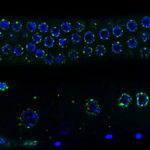Link to Pubmed [PMID] – 25993106
PLoS Genet. 2015 May;11(5):e1005194
RNA interference-related silencing mechanisms concern very diverse and distinct biological processes, from gene regulation (via the microRNA pathway) to defense against molecular parasites (through the small interfering RNA and the Piwi-interacting RNA pathways). Small non-coding RNAs serve as specificity factors that guide effector proteins to ribonucleic acid targets via base-pairing interactions, to achieve transcriptional or post-transcriptional regulation. Because of the small sequence complementarity required for microRNA-dependent post-transcriptional regulation, thousands of microRNA (miRNA) putative targets have been annotated in Drosophila. In Drosophila somatic ovarian cells, genomic parasites, such as transposable elements (TEs), are transcriptionally repressed by chromatin changes induced by Piwi-interacting RNAs (piRNAs) that prevent them from invading the germinal genome. Here we show, for the first time, that a functional miRNA pathway is required for the piRNA-mediated transcriptional silencing of TEs in this tissue. Global miRNA depletion, caused by tissue- and stage-specific knock down of drosha (involved in miRNA biogenesis), AGO1 or gawky (both responsible for miRNA activity), resulted in loss of TE-derived piRNAs and chromatin-mediated transcriptional de-silencing of TEs. This specific TE de-repression was also observed upon individual titration (by expression of the complementary miRNA sponge) of two miRNAs (miR-14 and miR-34) as well as in a miR-14 loss-of-function mutant background. Interestingly, the miRNA defects differentially affected TE- and 3′ UTR-derived piRNAs. To our knowledge, this is the first indication of possible differences in the biogenesis or stability of TE- and 3′ UTR-derived piRNAs. This work is one of the examples of detectable phenotypes caused by loss of individual miRNAs in Drosophila and the first genetic evidence that miRNAs have a role in the maintenance of genome stability via piRNA-mediated TE repression.

